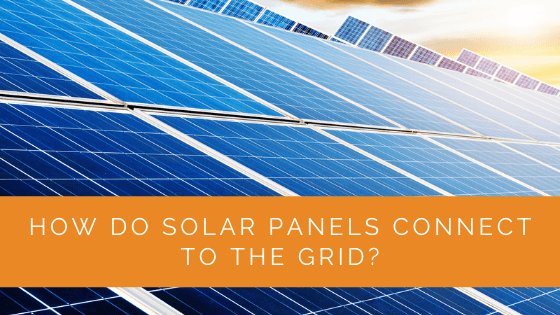Solar panels are a popular and eco-friendly way to power homes and businesses using the sun’s energy. This article explains how solar panels integrate with the electrical grid to transform sunlight into usable electricity. It discusses the role of solar inverters in converting direct current into alternating current, the importance of choosing the right inverter, the optional use of solar batteries, and the safeguarding roles of electrical shunts and circuit breakers. It also covers handling excess power, net metering, and different types of meters for a grid-tied solar system.
Contents
- 1 Key Takeaways
- 2 What is a Grid?
- 3 What is a Solar Inverter?
- 4 What are the Qualities of a Suitable Inverter?
- 5 When are Solar Batteries Required?
- 6 What are the Benefits of Using a Solar Battery?
- 7 What is an Electrical Shunt?
- 8 What is a Circuit Breaker?
- 9 What to do with Excess Power Generated?
- 10 What are the Different Types of Meters You Will Need?
- 11 Experience Solar Excellence with Us!
- 12 Conclusion
Key Takeaways
- Solar panels connect to the power grid, which is a complex network that receives electricity from various sources and distributes it to customers through generators, transformers, and power lines.
- Solar inverters play a crucial role in converting the direct current (DC) electricity generated by solar panels into alternating current (AC) electricity that can be used in homes. Choosing the right inverter is essential for efficient energy conversion.
- While not always necessary, solar batteries can store excess solar power for use during unfavorable weather conditions. They help prevent blackouts and reduce electricity bills by utilizing stored energy when needed.
What is a Grid?
The first step in understanding how your solar panel is connected to the grid is knowing what a grid actually is. A power grid is basically an elaborate bridge or network connecting the various firms that electricity passes through to finally reach the customers.
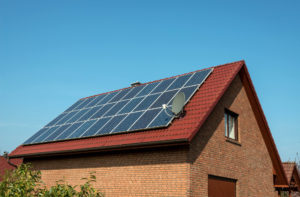 The grid is also known as the electricity grid that receives its power supply from the generator. This power supply is produced by specific processes from coal, wind, sunlight, or water.
The grid is also known as the electricity grid that receives its power supply from the generator. This power supply is produced by specific processes from coal, wind, sunlight, or water.
The grid-connected power lines are used to transfer this energy from a lower voltage to a higher voltage. This process is done by a specialized device called a transformer.
There are two types of transformers through which electricity passes. They are called step-up and step-down transformers. After this process, the grid electricity is finally distributed to the customers.
Hence, generators, transformers, and power lines are all a part of grid-tied systems. These grid-tied systems work together to generate electricity.
What is a Solar Inverter?
Once you have purchased and assembled your solar panels with the help of a professional, the next step involves connecting them to the grid power in a grid-tied system.
Solar inverters are devices that convert the power generated by your solar panel to grid power. There are two primary forms in which current flows. They are direct current and alternating current.
Direct current involves the flow on charge in a single direction only, whereas the alternating current constantly changes its direction of flow of charge.
For houses, electricity is mainly used in the form of alternating current, but a solar panel system generates electricity in the form of direct current or DC electricity. Hence, solar power needs to be converted to the appropriate form of current for use.
This DC electricity generated from absorbed solar energy has no good use in its natural form. Hence, solar inverters are used to convert the DC power into AC power.
An inverter consists of transistors that are rectifying devices. These transistors provide power to the grid in the form of alternating current, which is electricity usable for appliances.
What are the Qualities of a Suitable Inverter?
A solar inverter is an indispensable component of your solar PV system. Hence, it is necessary to know what traits you should look for while purchasing an inverter.
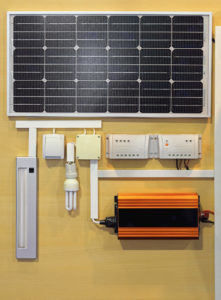 Another name for solar inverters is a grid-tie inverter, and they are available in many forms in the market. These inverters are used for grid-tied systems. String inverters are some of the most common types of inverters used.
Another name for solar inverters is a grid-tie inverter, and they are available in many forms in the market. These inverters are used for grid-tied systems. String inverters are some of the most common types of inverters used.
These inverters use a solar array in their functioning. A solar array is a smaller version of solar panels that are joined together systematically.
Another type of inverter is a power optimizer. Power optimizers work together with a string inverter to convert electricity generated by a solar power system. They are usually preferred over a string inverter because they have the ability to shut down in case of emergencies quickly.
A high-quality inverter is capable of producing power to the grid-tied system consistently. It must not create any fluctuations in sending power to the power grid.
The inverter’s conversion rates should be at least greater than ninety-five percent to ensure maximum solar electricity conversion.
The inverters should be updated to meet the latest requirements of the national electrical code to ensure the safe utilization of your solar energy system.
When are Solar Batteries Required?
Another device you can add to your grid-tied solar system is a solar battery. Your grid-connected system needs an inverter, but a solar battery is not absolutely necessary.
A solar battery is a device that is used to store excess solar power in the form of excess electricity. This excess electricity generated can be used during times when your panels are unable to get adequate amounts of solar power.
These batteries use three primary electrodes made of lithium to store solar power. Most people prefer a lead-acid solar battery because it does not emit harmful gases and is hence easy to maintain.
Solar batteries are needed only when you choose to have your solar panels as the sole source of power generation in your house. During unfavorable weather conditions, such as heavy rainfall and cloudy days, your solar panels will not be able to absorb the required amount of solar power.
As a result, your home’s power generation will be affected. But, if you have a solar battery connected to your solar panels, the surplus electricity produced on other days can be utilized. Hence, this surplus electricity is effectively stored in these solar batteries.
You can choose to connect your solar panel to an inverter and then to a utility grid or connect the inverter to the solar battery and then finally to the utility grid.
What are the Benefits of Using a Solar Battery?
There are many benefits of using solar batteries because these are effective storage devices that prevent any form of blackouts.
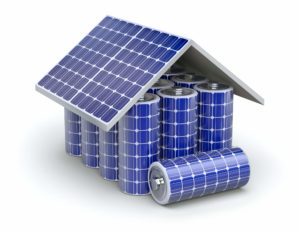 As a panel works based on the availability of solar power, there is a risk of significant fluctuations in the quantity of electricity.
As a panel works based on the availability of solar power, there is a risk of significant fluctuations in the quantity of electricity.
But with a solar battery, you need not worry about wasted electricity because these devices work on the principle of battery storage. So, if more power is generated on a particular day, this power will be stored in the battery.
Hence, you will have lesser electricity bills because you will not need the grid-tied electricity and instead have the means to produce your own electricity whenever required.
What is an Electrical Shunt?
An electrical shunt is a device that generates the most suitable pathway for the flow of more electricity. This shunt has the ability to switch on and off by itself.
In most systems, the shunt is connected to the solar battery. When it is switched on, it provides a path for the flow of energy. But, when there is an increase in the voltage of the battery, the shunt switches off, hence preventing the flow of more power.
Hence, the solar battery is protected from overload as the grid-tied power supply fed to it is constantly regulated. So, you can make an electrical shunt a part of your solar power system and install it as a preventive device.
What is a Circuit Breaker?
The solar cells present in your panels will record more activity on a sunny day because more photons are available. As a result, the extra supply of photons will make the solar cells produce more solar power.
This excess solar power will be transferred to the inverters present in your solar power system at a higher rate than average. These high rates have the ability to damage your inverters if the inverters are not able to handle the load.
Hence, your entire solar power system is at the risk of being severely damaged, which can cost a lot to repair.
You can install a circuit breaker in your solar systems to prevent these hazardous scenarios. A circuit breaker will create an interruption in the flow of current, hence avoiding any form of short circuit.
What to do with Excess Power Generated?
The power generated by a panel is directly dependent on the availability of enough solar energy. On some days, there could be high availability of energy that produces excess power.
A utility company available in your area is mainly responsible for handling any form of extra power generated. This utility company works with customers based on a policy called net metering.
The net metering policy is an agreement of net billing that allows users to use their own generated energy in the form of electricity whenever they need to. Net metering is a policy that mainly applies to solar power system owners.
Hence, net metering allows users to store all of the energy produced via solar systems to be used directly from the grid at no extra cost.
What are the Different Types of Meters You Will Need?
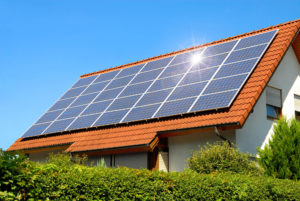 You can approach any utility company for an electricity meter if you own solar systems. This device is highly relevant for a grid-tied solar system. However, off-grid solar systems do not require this meter.
You can approach any utility company for an electricity meter if you own solar systems. This device is highly relevant for a grid-tied solar system. However, off-grid solar systems do not require this meter.
An electric meter is a device that tells you how much electricity produced is consumed by your house. This electricity consumption will include the electricity coming from your solar systems and the electricity coming from your power grid.
This meter helps utility companies generate accurate electricity bills charging you for the power consumed from the grid.
A net meter is a type of meter that helps you know the amount of solar power that was transferred from the solar system to the grid. The amount of solar power transported is compensated by a reduced bill to the customers.
The utility meter is similar in function to a net meter. It keeps a record of the amount of solar power that is transported from the solar system to the grid. Apart from these, there are many utilities that will help you track the power generated by your solar system.
These meters are additional components that you can add as a part of your solar system to get lower current bills from utility companies.
Experience Solar Excellence with Us!
Trust in Solar Panels Network USA, where our seasoned experts deliver top-quality solar solutions for homes and businesses nationwide. With a legacy of countless successful installations and a commitment to sustainable energy, we’re your reliable partner in the solar journey. Ready for a brighter, eco-friendly future? Call us now at (855) 427-0058 and harness the power of the sun!
Conclusion
There are a number of systems that are a part of the connection mechanism of your panels to the grid. Before buying a solar system, you should have in-depth knowledge about its working.
The rapid rate of climate change has pushed humans to find alternate sources of energy. Although sometimes solar panels can take several weeks to be fully functional, they are excellent sources of energy that can be utilized by houses and industries to power various systems.
Many governments around the world are providing many monetary benefits to individuals who install solar power systems. Hence, people are encouraged to take a step towards using a more sustainable form of energy.
About the Author
Solar Panels Network USA stands at the forefront of solar energy solutions, driven by a team of seasoned solar engineers and energy consultants. With over decades of experience in delivering high-quality solar installations and maintenance, we are committed to promoting sustainable energy through customer-centric, tailored solutions. Our articles reflect this commitment, crafted collaboratively by experts to provide accurate, up-to-date insights into solar technology, ensuring our readers are well-informed and empowered in their solar energy decisions.

